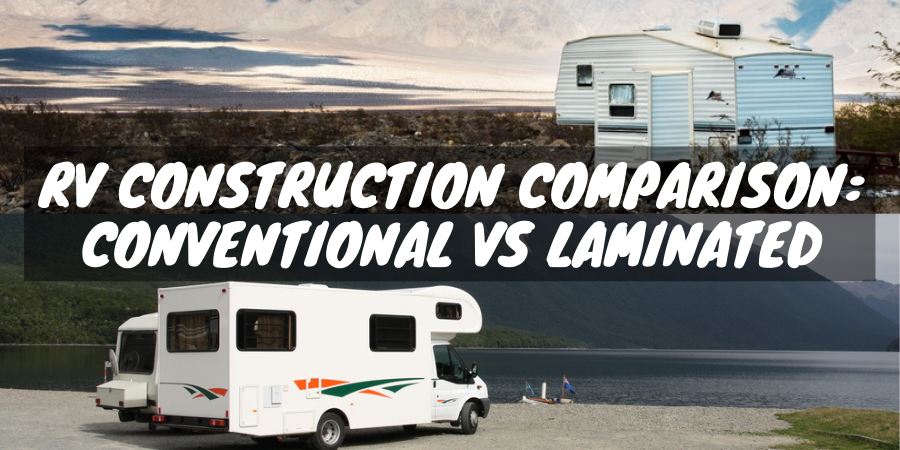In the travel trailer RV category, there are two different building methods RV manufacturers use.
A conventional travel trailer, known as the stick and tin method, uses a wood frame and corrugated aluminum paneling for the sidewall exterior skin.
Laminated travel trailers use an aluminum frame with flat fiberglass panels on the door and off-door sides of the RV. The term “laminated” refers to the manufacturing process of sealing the multiple layers of the wall together.
Many first-time and veteran RV shoppers wonder which is the best travel trailer construction, conventional or laminated.
I’ll walk you through the most important topics of consideration when comparing the two travel trailer-building methods. At the end of each topic, I’ll show you which RV construction building method wins the case or if they’re equal and why.
You’ll also learn about a travel trailer that hybridizes both construction methods.
Are There Currently RV Building Supply Shortages?
If you’ve kept up with the news, you keep hearing about the various RV building material shortages the industry deals with daily.
Those who recently purchased a new RV have an average wait time of 4 months to take delivery.
Yet, if you were to drive by many manufacturers, you’d see rows of what looks like completed coaches lined up in their lots.
Those dormant motorhomes and travel trailers are waiting for one or two missing components from third-party vendors RV manufacturers use to build their coaches.
The various vendors are also waiting for parts or sort out manufacturing complications.
You can learn all about the issues involved with the backlog in our discussion about buying a new RV in this backlog market.
If you’re going to buy a new RV while the industry is going through these issues, order what’s right for you, as RVs are a significant investment.
Side By Side Comparision: Wood Frame versus Aluminum Frame
I’ll use the Forest River Wildwood 22RBS to represent the conventional building method and the Forest River Wildwood Heritage Glen Hyper-Lite 22RBHL for the laminated version when I’ll go through each topic.
Both units are travel trailers under 30 feet and have the same floorplan, making them travel trailers with rear bathrooms.
Here are the specs for each coach:
| SPEC | CONVENTIONAL BUILD | LAMINATED BUILD |
|---|---|---|
| Name | Forest River Wildwood 22RBS | Forest River Wildwood Heritage Glen Hyper-Lite 22RBHL |
| Length | 26.11 ft. | 27.11 ft. |
| Dry Weight | 5,928 lbs. | 5,413 lbs. |
| GVWR | 7,765 lbs. | 7,570 lbs. |
| CCC | 1,837 lbs. | 2,157 lbs. |
| Fresh Tank | 40 gal. | 49 gal. |
| Grey Tank | 60 gal. | 62 gal. |
| Black Tank | 30 gal. | 32 gal. |
| Fridge | 11 cu. ft. | 10.7 cu. ft. |
| Shower | 24 x 40 inches | 30 x 36 inches |
| Master Bed | 60 x 80 inches res. Queen | 60 x 74 inches Short Queen |
| Retail Price | $34,206 | $41,528 |
Forest River-Wildwood Heritage Glen Hyper-Lyte-22RBHL (Video)
Forest River Wildwood 22RBS(Video)
What Is the Best Type of RV Construction?
As I explore each topic, I’ll further explain the details of the conventional and laminated construction methods.
Aesthetic Appeal
2021 Forest River Wildwood 22RBS (picture at left) vs 2021 Forest River Wildwood Heritage Glen Hyper-Lyte 22RBHL (picture at right)
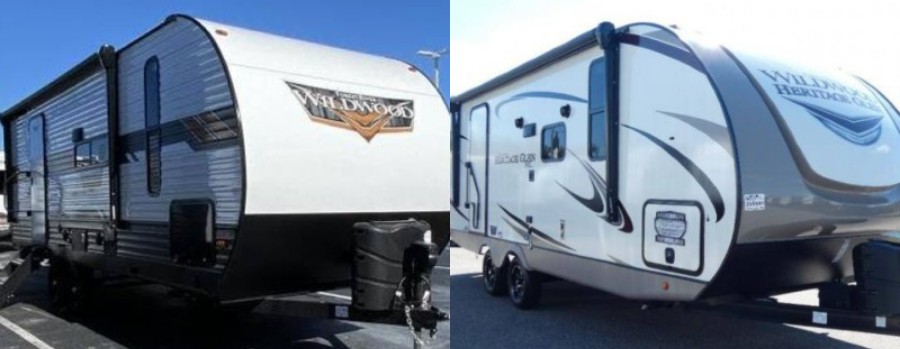
When you first look at the Wildwood 22RBS and the Hyper Lyte 22RBHL side-by-side, the outer skin differences are apparent.
Instead of two-toning the door and storage bay on the conventional trailer, Wildwood makes these door panels black to compliment the exterior, working with the contouring of the aluminum siding.
The Hyper Lyte has clean lines and flat paneling; others may prefer using dark tan as a single accent.
Historically, conventional travel trailers used decals instead of paint for labeling and stylistic markings.
The less expensive decals were cheaper and easier to configure to the uneven surface of the aluminum.
Today’s computer technology has leveled the playing field so both exteriors can use paint.
Aesthetic Appeal Winner: TIE
Cleaning
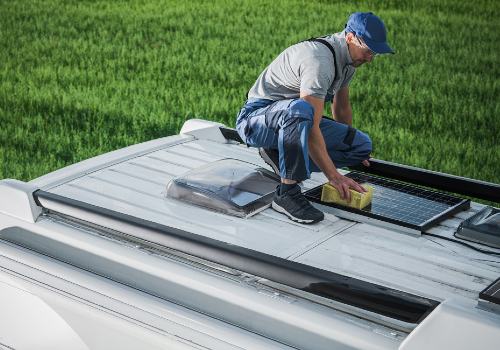
As innovative as cleaning products are, there are still seams, nooks, and crannies in the corrugated aluminum you’re going to have to hand scrub.
You shouldn’t buy or rent a pressure washer to clean your travel trailer. The water pressure will destroy your decals, paint, and other sensitive components, no matter which type of RV exterior you have.
If you were to ask a detailer who cleans RVs all day, they’d say the best siding for a travel trailer is the fiberglass panels on an aluminum-framed coach.
I always recommend handwashing versus taking it to a commercial truck wash that accepts RVs.
The equipment on your roof, like your various antennas, can’t handle the water pressure from the water jets.
Cleaning Winner: Laminated
Conduction in Frame
We all know that metal is a conductor. Your RV’s insulation surrounds your aluminum framing, but it’s still connected to the exposed steel chassis.
RV manufacturers do their best to minimize the frame’s impact on the interior temperature, but your coach isn’t Fort Knox.
To be clear, the seepage we’re talking about can be a difference between 1-3 degrees in average temperatures, but extreme summers and winters may be slightly higher.
Stick and tin conventional travel trailers are recommended in extreme temperatures.
Wood is an insulator. The average R-value of wood per inch is 1.41 for softwoods and 0.71 for hardwoods. Modern Era (2008 to Present) RVs use pressure-treated softwoods that are amazingly strong, sustainable, and use eco-friendly treatment techniques.
Conduction in Frame Winner: Conventional
Corrosion Resistance
As I mentioned above, conventionally built travel trailers use pressure-treated softwoods with weight-bearing properties.
The wood’s treatment makes it resistant to moisture, pests, mold, and mildew.
With proper maintenance on your RV’s seals, the elements won’t test the wood frame’s resistance for most of its life.
Welded aluminum frame campers are naturally bug-proof, mold-proof, mildew proof, and it takes years of constant exposure to moisture before you have to worry about rusting.
You’ll know you have a leak and get it repaired before the aluminum frame shows evidence of oxidation.
Corrosion Resistance Winner: Laminated
Features
The framing and exterior skin do influence the type of features contained in an RV. When you compare the 22RBS and the 22RBHL components against each other, it boils down to personal choice.
The Hyper Lyte will have a few more features than its conventional counterpart.
Laminated travel trailers will be more feature-focused than the stick and tins. Does this make aluminum frame campers good; you decide.
Features Winner: Laminated
Insulation
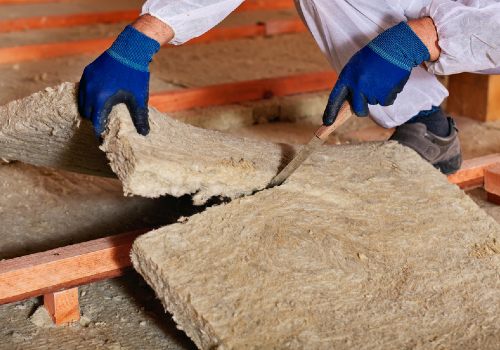
There is a difference in the types of insulation used in the RV construction methods. Aluminum frame RV manufacturers use rigid foam in the sidewalls with an average R-value of R-3.5 to R-5.
If they use Azdel for added strength, the material has its own R-value of 2-3. Most likely, you can expect a laminated travel trailer to have a combined sidewall R-value of R-7.
Wood frame travel trailers still use fiberglass batt. If you’re a child of the 1980s, you’ll remember those TV commercials where the cartoon character,
The Pink Panther rolled out that pink cotton candy-like rolls of insulation in a house attic.
RVs use a yellow version with an R-value of R-25. An R-value this high doesn’t automatically make your travel trailer all-season-ready, but July camping in Miami, Florida, can be comfortable.
Insulation Winner: Conventional
Pricing
- WW Heritage Glen Hyper Lyte 22RBHL: $41,528
- Wildwood 22RBS: $34,206
- Price Difference: $7,322
To adequately express our feelings on this, we’ll say it in the style of Burt Ward’s Robin character from the 1966-1968 Batman TV Show, “Holy Benjamins Batman, that’s a big price gap!”
Laminated travel trailers require specialized tools and machines. Employees need additional training and certifications to perform their jobs.
Higher-cost materials and longer construction times also factor into the pricing equation.
The aluminum frame laminated building method started in the mid-Classic Era (1971-1989) and is still evolving.
Making changes to a design requires advanced computer programming to adjust the machines.
Conventional RV construction dates back to the Antique Era (1910-1944). RV manufacturers use the commercial-grade versions of the tools you have in your toolbox.
Even if the manufacturer uses imported materials (birch from Eastern Europe is popular for cabinets and framing), a few weeks of training and apprenticeship will have a new employee working to expectations.
Price Winner: Conventional
Repairs
Suppose two people bring their travel trailers to the same RV service center for the same problem. One of their sidewall frame supports failed. The first person has a conventionally built travel trailer, and the other has a laminated RV. When the service center manager gives each of them the estimate, here’s what they see:
- Conventional: 4 hours of labor, $400 total cost, and the RV will be ready in 3 days.
- Laminated: 24 hours of labor (4 techs working 6 hours), $3,500 total cost, and the RV will be ready in 3 weeks.
Since we’re not RV service repair technicians or have any experience in the field, don’t rely on the data above as accurate guides to this type of repair.
I can say that repairing a frame support or anything in the sidewall of a laminated sidewall is vastly more complex than a conventional coach.
During construction, the sidewall of an aluminum-framed travel trailer starts as a giant fiberglass panel cut to size.
The aluminum frame parts, cabinetry mounts, door frames, electrical wiring, rigid foam insulation, plumbing, and window supports get tacked on the panel. It then goes through the pressure sealing and lamination binding process.
To replace any of those parts, the RV service center must order a new side panel with all the components attached.
Stick and tin coaches are simpler to fix. One RV service technician can detach the interior wall, remove the broken wood frame support, and replace it with a new one.
The only thing they may have to wait for is the 2 x 4 wood beam from the RV manufacturer because the service center must replace it with the same type of pressure-treated wood the RV company uses.
Repairs Winner: Conventional
Towability
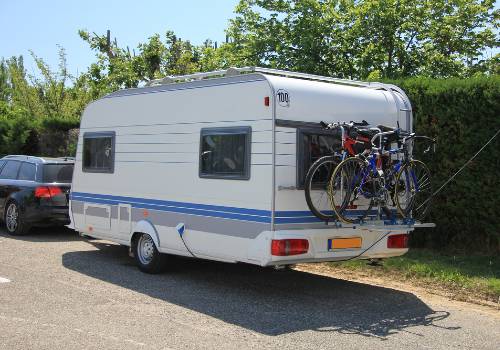
Aluminum-framed travel trailers have an edge on travel days.
The difference is minor, but physicists who specialize in aerodynamics can show you in detail the relationship between wind and surface space.
Air must make contact with every millimeter of the corrugated aluminum paneling on the wood-framed RV.
When you’re traveling, the moving air must do this as well.
A fundamental principle in aerodynamics says that the more surface space you have, the more wind resistance you create.
If you were to flatten out the corrugation of the aluminum paneling, you’d find out that the actual surface space is over double the original size.
Want to Connect With a Community of Over 1,078 RV Enthusiasts?
This increased wind resistance does affect your fuel efficiency.
Full-timers who travel heavily may find that they could’ve saved a whole tank of gas after a few months of traveling, so the loss is fractional.
The laminated sidewalls create a smooth surface that’s aerodynamically ideal.
Towability Winner: Laminated
Effects to Weight
- Laminated: WW Heritage Glen Hyper Lyte 22RBHL
- Dry Weight: 5,413 lbs.
- GVWR: 7,570 lbs.
- CCC: 2,157 lbs.
- Conventional: Wildwood 22RBS
- Dry Weight: 5,928 lbs. (+515 lbs.)
- GVWR: 7,765 lbs. (+195 lbs.)
- CCC: 1,837 lbs. (-320 lbs.)
We can draw some conclusions by looking at the dry weight, gross vehicle weight rating (GVWR), and the cargo carrying capacity (CCC) of both travel trailers.
The conventional trailer is heavier than the Hyper Lyte by 515 pounds yet can handle less cargo weight than the laminated coach.
Generally, conventional travel trailers are heavier than their counterparts.
The 320-pound cargo capacity comes from the various engineering choices made during its development.
As an RV shopper, these weight differences can help you decide which travel trailer fits your RV lifestyle better.
A 515-pound dry weight difference can mean the difference between using a half-ton pickup truck or a full-size SUV.
320 pounds of storage space for your camping gear is big enough to dictate how long your adventure will be and what kind of outdoor adventure gear you can explore while you’re on your trip.
What About the Roof and Floor?
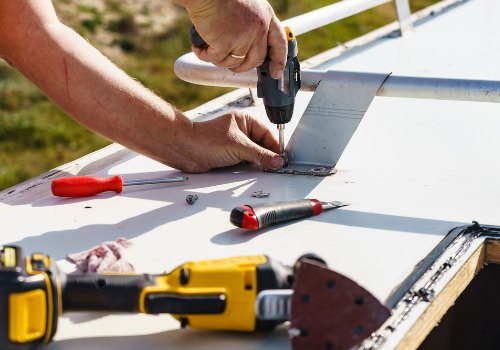
When you look at the front and rear caps of both the conventional and laminated travel trailers, you’ll see that both RV construction methods use fiberglass on each end (during the RV shortage, some use aluminum on the back as a substitute).
Both the front and rear press the fiberglass panels into molding dyes for the RV manufacturer’s structural and design needs.
Many make the rear, roof, and front caps as one single fiberglass sheet, reducing the seams to the roof-sidewall connection.
The side seams have gutter channels, adding another layer of protection from water getting into the walls.
Under the roof, you’ll find the top of the wood or aluminum frame, but the actual roof supports are typically wood with fiberglass batt.
That’s why RV roofs have the highest R-values.
RV underbellies have corrugated plastic sheeting that protects the undercarriage from road debris and pests from crawling inside.
The insulation is usually reflective bubble sheeting and/or rigid foam, regardless of the framing method.
When you really look at it, no matter what the sidewalls, frame, or features may be, the top, bottom, front, and back are the same.
What’s the Best Travel Trailer for Your Money?
The best travel trailer for your money is the one that fits your RV lifestyle the best.
If you have your heart set on the mid to full-length travel trailer RV category, here’s the best scenario for a conventional and laminated coach.
Conventional Travel Trailer Ideal Use
If you’re the type of RVer who likes to stay longer and travel less, you’ll enjoy a conventional travel trailer.
These coaches are great for most climates and seasons since they are better equipped to contain your internal climate control temperatures.
By keeping up with your RV’s preventive maintenance, you won’t have to worry too much about pests or corrosive agents attacking your frame.
You can rest easy if you need a repair completed since this tried and true building technique is easy to fix.
Your travel trailer may not come with the fanciest gadgets and gizmos, but adding your customizations and updates won’t be a problem as long as you’re good with your hands.
Laminated Travel Trailer Ideal Use

While more expensive than their counterparts, you’ll get what you pay for with an aluminum-framed travel trailer.
These lightweight RVs slip through the air, giving you an extra edge on your fuel efficiency.
You’ll also have state-of-the-art components inside your RV, making it feel like you’re living in a high-tech home with the latest interior design stylings.
Whether you’re a glamper, extreme sporter, or the one that got stuck bringing everything for the event, your cargo-carrying capacity can take the weight.
If your travel trailer needs a quick scrub, an extension brush and a bucket of water with RV cleaner will get that laminated clear coat shining in less than an hour.
Whether you’re a first-time fifth-wheel renter just starting your journey into the camping lifestyle or a fourth-generation legacy RVer who’s full-timing in their third motorhome, there’s always something new to learn.
Welcome to the RV lifestyle.
"Man cannot discover new oceans unless he has the courage to lose sight of the shore."
-- Andre Gide

